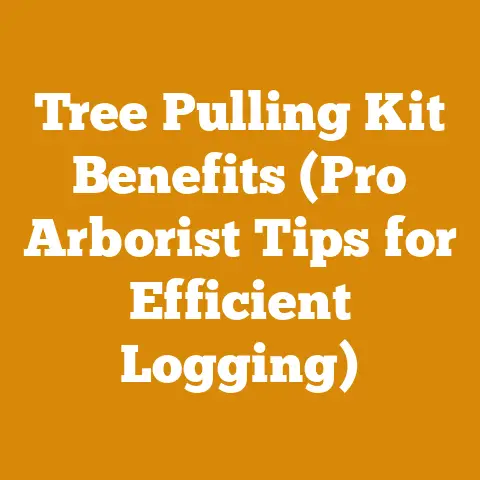Clearing Land by Hand (5 Expert Techniques for Tough Terrain)
For the discerning homeowner with acres to reclaim, or the forward-thinking homesteader carving out a sustainable life, the question isn’t if land clearing will be necessary, but how.
While heavy machinery might seem like the obvious answer, there’s a growing movement – a quiet rebellion, if you will – towards a more hands-on, ecologically conscious approach.
I’m talking about clearing land by hand.
It’s a slower process, certainly, but one that yields a deeper connection to the land and, surprisingly, can be quite cost-effective when you factor in the long game.
Clearing land by hand isn’t just about brute force.
It’s about strategy, understanding the terrain, and employing the right techniques.
And like any worthwhile endeavor, it comes with its own set of financial considerations.
From the initial investment in tools to the ongoing costs of maintenance and labor (even if that labor is your own sweat equity), understanding the financial landscape is crucial.
So, let’s roll up our sleeves and dive into the world of manual land clearing, exploring the techniques, the costs, and the strategies to keep your project on track.
Clearing Land by Hand (5 Expert Techniques for Tough Terrain)
Clearing land by hand, especially in tough terrain, presents a unique set of challenges and opportunities.
This approach emphasizes precision, minimal environmental impact, and a deeper understanding of the land.
While it may seem daunting, employing the right techniques and understanding the associated costs can make it a feasible and rewarding endeavor.
1. Assessment and Planning: Know Your Enemy (and Your Budget)
Before you even think about swinging an axe, the first step is a thorough assessment of your land.
This is absolutely crucial for accurate budgeting.
Think of it like this: you wouldn’t start building a house without blueprints, would you?
- Terrain Analysis: Is it rocky, sloped, heavily wooded, or a combination of all three?
The steeper the slope, the more difficult and time-consuming the clearing process.
Rocky terrain adds wear and tear on your tools and potentially requires specialized equipment for removing larger stones. - Vegetation Inventory: What kind of trees and undergrowth are you dealing with?
Are there invasive species that require special handling?
The type and size of trees will directly impact the tools you need and the time it takes to clear them.
For instance, removing a stand of mature oaks will be far more labor-intensive than clearing a patch of saplings. - Soil Type: Understanding your soil type is critical for determining future use of the land.
Is it suitable for gardening, pasture, or building?
This knowledge will influence your clearing methods.
For example, if you plan to garden, you’ll want to avoid methods that excessively disturb the topsoil. - Mapping: Create a detailed map of the area, marking obstacles, utilities (if any), and areas of particular concern.
This map will serve as your guide throughout the clearing process.
Include property lines, drainage patterns, and any protected areas that require avoidance. - Budgeting Begins: This assessment informs your initial budget.
This is where you start listing out the tools you need, potential rental costs, and an estimate of your time commitment.
Personal Story: I once jumped into a land-clearing project without a proper assessment.
I figured, “How hard could it be?” Turns out, very hard.
I significantly underestimated the number of rocks hidden beneath the surface, which led to broken tools, wasted time, and a much larger budget than anticipated.
Lesson learned: a thorough assessment is worth its weight in gold.
Cost Factors:
- Professional Survey (Optional): $500 – $2,000+ depending on property size and complexity.
While optional, a professional survey can save you headaches down the line by clearly defining property lines and identifying potential issues. - Soil Testing Kit: $20 – $50.
This is a worthwhile investment if you plan to use the land for gardening or agriculture. - Mapping Software/Tools: $0 – $100.
You can use free online tools like Google Earth or invest in dedicated mapping software. - Time: This is the most significant, and often overlooked, cost.
Estimate the number of hours required for the assessment and planning phase.
Actionable Takeaway: Don’t skip this step!
Invest the time and resources upfront to thoroughly assess your land.
It will save you time, money, and frustration in the long run.
2. Selective Clearing: Prioritizing and Minimizing Impact
Selective clearing is the art of removing only what’s necessary, leaving the rest of the ecosystem intact.
This approach is particularly important in sensitive environments or if you want to maintain a natural aesthetic.
- Identify Target Vegetation: Determine which trees and shrubs need to be removed based on your goals.
Are you creating a building site, a pasture, or a garden?
Mark these plants clearly.
Consider the long-term impact of removing specific trees. - Protect Valuable Trees: Take measures to protect trees you want to keep.
This might involve fencing, wrapping trunks, or pruning branches to prevent damage during the clearing process. - Undergrowth Management: Manage undergrowth selectively.
Instead of clear-cutting everything, consider pruning and thinning to improve sunlight penetration and air circulation. - Invasive Species Removal: Prioritize the removal of invasive species that can outcompete native plants and disrupt the ecosystem.
Be sure to dispose of invasive species properly to prevent their spread. - Stump Removal Considerations: Decide whether you need to remove stumps.
Stump removal is a labor-intensive and potentially costly process.
If you can leave the stumps in place, they will eventually decompose and enrich the soil.
Personal Story: I remember helping a friend clear a small area for a cabin.
He was initially gung-ho about removing everything.
I convinced him to leave a few mature pines, and it made all the difference.
The pines provided shade, privacy, and a sense of connection to the surrounding forest.
Cost Factors:
- Pruning Shears and Loppers: $30 – $100. Essential for managing undergrowth and pruning branches.
- Hand Saw: $20 – $50. Useful for smaller trees and branches.
- Herbicide (for Invasive Species): $20 – $50 per gallon.
Use with caution and follow all label instructions.
Consider non-chemical alternatives whenever possible. - Protective Gear (Gloves, Eye Protection): $20 – $50. Safety first!
- Time: Again, this is a significant factor.
Selective clearing is more time-consuming than clear-cutting but yields a more sustainable result.
Actionable Takeaway: Embrace selective clearing to minimize your impact on the environment and create a more natural and aesthetically pleasing landscape.
3. Hand Tools and Techniques: The Heart of Manual Clearing
This is where the rubber meets the road.
Choosing the right tools and mastering the techniques is crucial for efficiency and safety.
- Chainsaws: While the focus is on “by hand,” a chainsaw can be invaluable for felling larger trees.
However, safety is paramount.
Always wear appropriate safety gear and receive proper training before operating a chainsaw.- Cost Considerations: Chainsaws range from $150 for a basic electric model to $1,000+ for a professional-grade gas-powered saw.
Consider the size and type of trees you’ll be felling when choosing a chainsaw.
Maintenance costs include bar oil, chain sharpening, and occasional repairs. - Technique: Learn proper felling techniques to ensure the tree falls in the desired direction.
This requires understanding tree lean, wind direction, and potential obstacles.
- Cost Considerations: Chainsaws range from $150 for a basic electric model to $1,000+ for a professional-grade gas-powered saw.
- Axes and Mauls: Essential for splitting wood and felling smaller trees.
A good quality axe is an investment that will last for years.- Cost Considerations: Axes range from $50 to $200, depending on the quality and brand.
Mauls are typically used for splitting larger rounds and can cost $80 to $250. - Technique: Learn proper swinging techniques to maximize power and minimize fatigue.
Keep your axe sharp and maintain a safe stance.
- Cost Considerations: Axes range from $50 to $200, depending on the quality and brand.
- Bow Saws and Crosscut Saws: Excellent for smaller trees and branches.
These saws are quiet, environmentally friendly, and require no fuel.- Cost Considerations: Bow saws cost $20 to $50, while crosscut saws can range from $100 to $300.
- Technique: Use a smooth, even stroke and keep the blade sharp.
- Grub Hoes and Mattocks: Indispensable for removing roots and clearing undergrowth.
These tools are particularly useful in rocky or compacted soil.- Cost Considerations: Grub hoes and mattocks cost $30 to $80.
- Technique: Use a chopping motion to loosen the soil around the roots, then pry them out with the tool.
- Winches and Come-Alongs: Useful for pulling down trees or moving heavy logs.
These tools provide mechanical advantage and can significantly reduce the amount of manual labor required.- Cost Considerations: Winches and come-alongs range from $50 to $200.
- Technique: Secure the winch or come-along to a sturdy anchor point and use it to gradually pull the tree or log in the desired direction.
Personal Story: I’ve learned the hard way that using the right tool for the job is essential.
I once tried to fell a small tree with a dull axe, and it took me twice as long as it should have.
A sharp axe and the right technique would have made the job much easier and safer.
Cost Factors:
- Chainsaw: $150 – $1,000+
- Axe: $50 – $200
- Maul: $80 – $250
- Bow Saw: $20 – $50
- Crosscut Saw: $100 – $300
- Grub Hoe/Mattock: $30 – $80
- Winch/Come-Along: $50 – $200
- Safety Gear (Helmet, Eye Protection, Gloves, Chaps): $100 – $300
- Tool Maintenance (Sharpening, Repairs): $50 – $100 per year
- Fuel/Oil (for Chainsaw): $20 – $50 per month
- Time: This is where your physical stamina comes into play.
Factor in breaks and avoid overexertion to prevent injuries.
Actionable Takeaway: Invest in quality tools and learn how to use them properly.
This will save you time, effort, and potential injuries.
4. Stump Removal: Dealing with the Root of the Problem
Stump removal is often the most challenging and labor-intensive part of land clearing.
There are several methods you can use, each with its own pros and cons.
- Manual Removal: This involves digging around the stump, cutting the roots, and using a winch or come-along to pull it out.
This method is labor-intensive but environmentally friendly.- Cost Considerations: Primarily labor and the cost of tools like shovels, axes, and winches.
- Technique: Dig a wide trench around the stump, exposing the roots.
Cut the roots with an axe or saw, then use a winch or come-along to pull the stump out.
- Chemical Decomposition: This involves drilling holes in the stump and filling them with a chemical that accelerates decomposition.
This method is less labor-intensive but takes time (months or even years).- Cost Considerations: The cost of the chemical stump remover.
- Technique: Drill holes in the stump and fill them with the chemical.
Keep the stump moist to promote decomposition.
- Burning: In some areas, burning stumps is permitted.
This is a relatively quick and easy method but can be environmentally damaging and requires careful monitoring.- Cost Considerations: The cost of fuel and any required permits.
- Technique: Build a fire around the stump and let it burn until the stump is completely consumed.
Be sure to follow all local regulations and take precautions to prevent wildfires.
- Stump Grinding: This involves using a specialized machine to grind the stump into wood chips.
This method is relatively quick and effective but requires renting or hiring a stump grinder.- Cost Considerations: Rental fees for the stump grinder or the cost of hiring a professional stump grinding service.
- Technique: Follow the manufacturer’s instructions for operating the stump grinder.
Wear appropriate safety gear, including eye and ear protection.
Personal Story: I once spent an entire weekend trying to remove a large oak stump by hand.
It was backbreaking work, and I only managed to move it a few inches.
In hindsight, renting a stump grinder would have been a much more efficient and cost-effective solution.
Cost Factors:
- Chemical Stump Remover: $20 – $50 per application.
- Stump Grinder Rental: $100 – $300 per day.
- Professional Stump Grinding Service: $100 – $500 per stump (depending on size and location).
- Permits (for Burning): $0 – $50 (if required).
- Fuel (for Burning): $20 – $50.
- Time: Stump removal is time-consuming, regardless of the method you choose.
Actionable Takeaway: Carefully consider the pros and cons of each stump removal method before making a decision.
Choose the method that best suits your budget, time constraints, and environmental concerns.
5. Waste Management and Site Cleanup: The Final Touches
Once the clearing is complete, it’s time to deal with the waste and clean up the site.
This is an important step for both aesthetics and safety.
- Wood Utilization: Consider using the felled trees for firewood, lumber, or other purposes.
This can help offset the cost of the clearing project.- Cost Considerations: The cost of splitting and processing the wood.
- Technique: Split the wood into manageable pieces and stack it to dry.
Consider selling excess firewood to generate income.
- Brush Disposal: Dispose of brush and other debris properly.
This might involve burning (where permitted), chipping, or hauling it to a landfill.- Cost Considerations: The cost of renting a wood chipper or hauling debris to a landfill.
- Technique: Chip the brush into small pieces and use it as mulch.
Alternatively, haul the debris to a landfill or burn it in a controlled burn (where permitted).
- Erosion Control: Take measures to prevent erosion, especially on sloped terrain.
This might involve planting ground cover, installing erosion control blankets, or building retaining walls.- Cost Considerations: The cost of erosion control materials and labor.
- Technique: Plant ground cover to stabilize the soil.
Install erosion control blankets to protect exposed slopes.
Build retaining walls to prevent soil from sliding downhill.
- Site Leveling and Grading: Level and grade the site to prepare it for its intended use.
This might involve filling in holes, removing rocks, and smoothing the surface.- Cost Considerations: The cost of renting equipment like a tractor or skid steer.
- Technique: Use a tractor or skid steer to level and grade the site.
Fill in holes and remove rocks to create a smooth, even surface.
Personal Story: I once neglected to address erosion control after clearing a small hillside.
The first heavy rain washed away a significant amount of topsoil, creating a muddy mess and damaging the surrounding vegetation.
I learned my lesson: erosion control is essential for protecting the environment and preventing further damage.
Cost Factors:
- Wood Chipper Rental: $100 – $300 per day.
- Landfill Fees: $50 – $100 per load.
- Erosion Control Materials (Seed, Straw, Blankets): $50 – $200.
- Tractor/Skid Steer Rental: $200 – $500 per day.
- Hauling Costs: $50 – $100 per load.
- Time: Site cleanup can be time-consuming, especially if you have a lot of debris to dispose of.
Actionable Takeaway: Don’t neglect waste management and site cleanup.
Proper disposal of debris and erosion control measures are essential for protecting the environment and preparing the site for its intended use.
Calculating the Costs: A Deep Dive into the Numbers
Now that we’ve covered the techniques, let’s get down to brass tacks and talk about the actual costs involved.
This is where things can get a little tricky, as prices vary widely depending on your location, the size of the project, and the specific resources you use.
However, I can provide you with some general guidelines and benchmarks to help you estimate your budget.
Labor Costs: Your Sweat Equity vs. Hiring Help
The biggest variable in manual land clearing is labor.
Are you doing it all yourself, or are you hiring help?
- DIY Labor: If you’re tackling the project yourself, your labor cost is essentially the value of your time.
This is hard to quantify, but it’s important to consider.
How much is your free time worth?
Are you sacrificing other income-generating opportunities to clear the land? - Hired Labor: If you’re hiring help, labor costs can vary significantly depending on the skill level and experience of the workers.
General laborers might cost $15-$25 per hour, while experienced tree fellers or chainsaw operators could command $30-$50 per hour or more. - Task-Based vs.
Hourly Rates: You might be able to negotiate task-based rates for certain jobs, such as stump removal or brush chipping.
This can provide more cost certainty.
Cost Factors:
- Your Time (Opportunity Cost): Consider the value of your time and the potential income you’re foregoing.
- General Labor: $15 – $25 per hour.
- Experienced Tree Fellers/Chainsaw Operators: $30 – $50 per hour.
- Task-Based Rates: Negotiate rates for specific tasks, such as stump removal or brush chipping.
Benchmarking: According to the US Bureau of Labor Statistics, the median hourly wage for landscaping and groundskeeping workers was $17.74 in May 2022.
This can serve as a general benchmark for labor costs in your area.
Equipment Costs: Renting vs. Buying
As we discussed earlier, the cost of equipment can vary widely depending on whether you rent or buy.
- Renting: Renting can be a good option for tools you’ll only use occasionally, such as a stump grinder or wood chipper.
Rental fees typically range from $100-$300 per day, depending on the equipment. - Buying: Buying is a better option for tools you’ll use frequently, such as an axe, saw, or grub hoe.
A good quality axe can last for years with proper maintenance.
Cost Factors:
- Tool Rental Fees: $100 – $300 per day.
- Tool Purchase Costs: As outlined in the “Hand Tools and Techniques” section.
Benchmarking: Check with local rental companies to compare prices for different types of equipment.
Consider the long-term cost of ownership when deciding whether to rent or buy.
Material Costs: Fuel, Oil, and Consumables
Don’t forget to factor in the cost of fuel, oil, and other consumables.
- Fuel: Chainsaws and other gas-powered equipment require fuel.
The cost of fuel can add up quickly, especially if you’re running equipment for several hours each day. - Oil: Chainsaws also require bar oil to lubricate the chain.
The cost of bar oil is relatively low, but it’s an essential expense. - Consumables: Other consumables include chainsaw chains, axe sharpening stones, and gloves.
Cost Factors:
- Fuel: $20 – $50 per month.
- Bar Oil: $10 – $20 per month.
- Chainsaw Chains: $20 – $50 per chain.
- Axe Sharpening Stones: $10 – $20.
- Gloves: $10 – $20 per pair.
Benchmarking: Shop around for the best prices on fuel, oil, and consumables.
Consider buying in bulk to save money.
Disposal Costs: Landfill Fees and Burning Permits
Disposing of waste can also add to the cost of your project.
- Landfill Fees: Landfill fees vary depending on the location and the amount of waste you’re disposing of.
- Burning Permits: Some areas require permits for burning brush or stumps.
The cost of these permits is usually relatively low, but it’s important to factor them in.
Cost Factors:
- Landfill Fees: $50 – $100 per load.
- Burning Permits: $0 – $50 (if required).
Benchmarking: Check with your local landfill and fire department to determine the fees and permit requirements in your area.
Contingency Fund: Expect the Unexpected
It’s always a good idea to set aside a contingency fund to cover unexpected expenses.
Aim for at least 10-15% of your total budget.
Things always come up that you don’t anticipate, and it’s better to be prepared.
Case Studies: Real-World Examples of Manual Land Clearing Costs
To illustrate the cost factors discussed above, let’s look at a few hypothetical case studies.
Case Study 1: Small-Scale Garden Clearing
- Project: Clearing a 20×30 foot area for a garden.
- Terrain: Relatively flat, with light undergrowth and a few small trees.
- Labor: DIY.
- Equipment: Axe, saw, grub hoe, shovel.
- Waste Disposal: Brush chipping and composting.
- Stump Removal: None (small trees were easily uprooted).
Estimated Costs:
- Tools: $150
- Consumables: $20
- Contingency: $20
- Total: $190
- Time: 20 hours
Case Study 2: Medium-Scale Pasture Clearing
- Project: Clearing a 1-acre area for a pasture.
- Terrain: Sloped, with moderate undergrowth and several medium-sized trees.
- Labor: DIY with occasional help from friends.
- Equipment: Chainsaw, axe, maul, grub hoe, winch.
- Waste Disposal: Burning (with permit).
- Stump Removal: Chemical decomposition.
Estimated Costs:
- Tools: $500
- Consumables: $100
- Chemical Stump Remover: $50
- Permit: $20
- Contingency: $80
- Total: $750
- Time: 100 hours
Case Study 3: Large-Scale Building Site Clearing
- Project: Clearing a 2-acre area for a building site.
- Terrain: Rocky, with heavy undergrowth and several large trees.
- Labor: Hired professional tree fellers and laborers.
- Equipment: Chainsaw, axe, maul, grub hoe, stump grinder (rental).
- Waste Disposal: Landfill.
- Stump Removal: Stump grinding.
Estimated Costs:
- Labor: $4,000
- Equipment Rental: $600
- Landfill Fees: $400
- Consumables: $200
- Contingency: $520
- Total: $5,720
- Time: 40 hours
Important Note: These are just hypothetical examples.
Your actual costs may vary depending on your specific circumstances.
Tips for Cost Optimization: Saving Money Without Sacrificing Quality
Here are a few tips for optimizing your costs without sacrificing the quality of your land clearing project:
- Do Your Research: Shop around for the best prices on tools, equipment, and labor.
Don’t be afraid to negotiate. - Prioritize Safety: Invest in quality safety gear and take the time to learn proper techniques.
Preventing injuries will save you money in the long run. - Utilize Resources Wisely: Use felled trees for firewood, lumber, or other purposes.
Chip brush for mulch.
Compost organic waste. - Plan Ahead: A well-planned project is a cost-effective project.
Take the time to assess your land, develop a detailed plan, and create a realistic budget. - Don’t Be Afraid to Ask for Help: Enlist the help of friends, family, or neighbors.
Many hands make light work, and it can save you money on labor costs. - Consider a Cooperative: Team up with other landowners to share equipment and labor costs.
The Long-Term Value: Beyond the Immediate Costs
While this article has focused heavily on the immediate costs of manual land clearing, it’s important to consider the long-term value as well.
- Increased Property Value: Clearing land can significantly increase the value of your property.
- Sustainable Land Management: Manual land clearing is a more sustainable approach that minimizes environmental impact.
- Self-Sufficiency: Clearing land can enable you to grow your own food, raise livestock, or build a home, increasing your self-sufficiency.
- Connection to the Land: Clearing land by hand fosters a deeper connection to the land and a greater appreciation for the natural world.
Final Thoughts: Embracing the Journey
Clearing land by hand is a challenging but rewarding endeavor.
It requires careful planning, the right tools, and a willingness to work hard.
By understanding the techniques, the costs, and the strategies for cost optimization, you can successfully clear your land and create the space you need to pursue your dreams.
Remember, it’s not just about the destination, it’s about the journey.
Embrace the process, learn from your mistakes, and enjoy the satisfaction of transforming your land with your own two hands.
It’s hard work, no doubt, but there’s a special kind of satisfaction that comes from knowing you did it yourself, sustainably and consciously.
And who knows, maybe you’ll even save a few bucks along the way.
Now, get out there and make something amazing happen!






